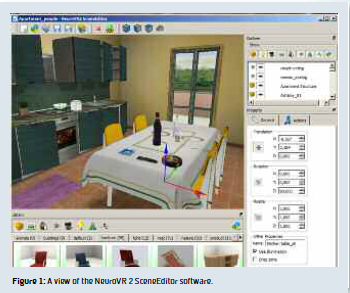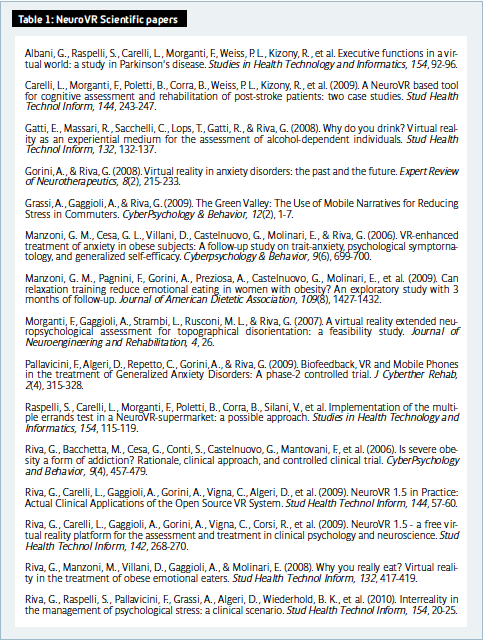By Giuseppe Riva, Andrea Gaggioli & Cinzia Vigna
Although the papers in previous issues of C&R have shown that Virtual Reality (VR) has come of age for clinical and research applications, the majority of them are still in the laboratory or investigational stage. Data presented at the 2010 Cybertherapy conference held in Seoul, Korea, showed that the real impact of VR in European behavioral health is still low:
- The penetration of VR in behavioral health care/research centers is minimal: around 0.5/1%
- The penetration of VR between behavioral health professionals is even lower: less than 0.001%
Why is VR more virtual than real for many health care practitioners? From the experience of the current researchers involved in this area it is possible to identify four major issues that are limiting the use of VR in psychotherapy and behavioral neuroscience:
- the lack of standardization in VR hardware and software, and the limited possibility of tailoring the virtual environments (VEs) to the specific requirements of the clinical or the experimental setting;
- the low availability of standardized protocols that can be shared by the community of researchers;
- The high costs (up to 100.000 ¤) required for designing and testing a clinical VR application;
- most VEs in use today are not userfriendly; expensive technical support or continual maintenance is often required.
To address these challenges, the European funded project Interstress (http://www.interstress.eu) is developing NeuroVR 2 (http://www. neurovr2.org), an advanced version of the cost-free NeuroVR platform based on open-source software that allows non-expert users to easily modify a virtual environment (VE) and to visualize it using either an immersive or non-immersive system (http://www.neurovr.org). NeuroVR, originally developed by the Virtual Reality & Multi Media Park (http://www.vrmmp.it) for the Italian MIUR Firb NeuroTIV and IVT2010 projects, received the 2007 Laval Virtual Science Award for the best VR science application worldwide.
The majority of existing VEs for health care are proprietary and are closed source, meaning they cannot be tailored from the ground up to fit specific needs for different clinical applications. NeuroVR 2 addresses these issues by providing the clinical professional with a cost-free SceneEditor, which allows nonexpert users to easily modify a virtual scene to best suit the needs of the clinical setting.
The VR suite leverages two major opensource projects in the VR field: Delta3D (http://www.delta3d.org) and Open- SceneGraph (http:// www.openscenegraph. org). Both are building components that integrates with ad-hoc code to handle the editing and simulation. The NeuroVR2 SceneEditor’s GUI is now based on the QT cross-platform application and UI framework from Nokia (http://qt.nokia.com/) that grants an higher level of editing and customization over the editor functionalities, while the graphical rendering is done using OpenSceneGraph, an open source high performance 3D graphics toolkit (http://www.openscenegraph.org/projects/ osg).
Using the NeuroVR 2 SceneEditor (see Figure 1), the psychological stimuli/stressors appropriate for any given scenario can be chosen from a rich database of 2D and 3D objects, and easily placed in the pre-designed virtual scenario by using an icon-based interface. No programming skills are required to carry out these steps. In addition to static objects, the NeuroVR 2 SceneEditor allows objects to overlay on the 3D scene video composited with a transparent alpha channel. The editing of the scene is performed in real time, and effects of changes can be checked from different views including frontal, lateral and top.

Currently, the NeuroVR 2 library includes different pre-designed virtual scenes representing typical real-life situations such as a supermarket, an apartment, or a park. These VEs have been designed, developed and assessed in the past ten years by a multidisciplinary research team in several clinical trials involving over 400 patients. On the basis of this experience, only the most effective VEs have been selected for inclusion in the NeuroVR 2 library.
An interesting feature of the NeuroVR 2 SceneEditor is the ability to add new objects to the database. This feature allows the therapist to enhance the patient’s feeling of familiarity and intimacy with the virtual scene, i.e., by using photos of objects/people that are part of the patient’s daily life, thereby improving the efficacy of exposure. The second main component of NeuroVR 2 is the Player, which allows navigation and interaction with the VEs created using the NeuroVR 2 SceneEditor. The player offers a set of standard features that contribute towards increasing the realism of the simulated scene. These include collision detection to control movements in the environment, realistic walk-style motion, advanced lighting techniques for enhanced image quality, and streaming of video textures using alpha channel for transparency. The player can be configured for two basic visualization modalities – immersive and non-immersive. The immersive modality allows the scene to be visualized using a head-mounted display, either in stereoscopic or in mono-mode; compatibility with the head-tracking sensor is also provided. In the non-immersive modality, the virtual environment can be displayed using a desktop monitor or a wall projector. The user can interact with the virtual environment using either keyboard commands, or a mouse or a joypad, depending on the hardware configuration chosen.
A future goal is to provide software compatibility with instruments that allow collection and analysis of behavioral data, such as eye-tracking devices and sensors for psycho-physiological monitoring. Actually, the neuro platform is used in the assessment and treatment of obesity, alcohol abuse, anxiety disorders, generalized anxiety disorders and cognitive rehabilitation (see Table 1 for a list of published papers that used the NeuroVR software).

Beyond clinical applications, NeuroVR provides the VR research community with a free “VR lab,” which allows the creation of highly-controlled experimental simulations for different behavioral, clinical and neuroscience applications.
Giuseppe Riva, Ph.D. Andrea Gaggioli, Ph.D. Cinzia Vigna, Ph.D. Istituto Auxlogico Italiano Italy giuseppe.riva@unicatt.it
About Brenda Wiederhold
President of Virtual Reality Medical Institute (VRMI) in Brussels, Belgium.
Executive VP Virtual Reality Medical Center (VRMC), based in San Diego and Los Angeles, California.
CEO of Interactive Media Institute a 501c3 non-profit
Clinical Instructor in Department of Psychiatry at UCSD
Founder of CyberPsychology, CyberTherapy, & Social Networking Conference
Visiting Professor at Catholic University Milan.






